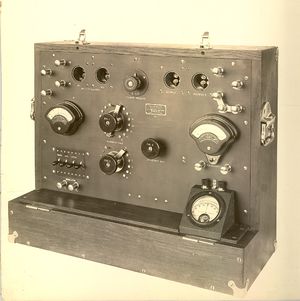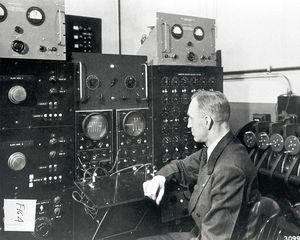Electrical Technology Comes to the Laboratory
Scientific laboratories were radically transformed in the early decades of the 20th century by the coming of electrical and electronic technologies.
First of all, electrification of the laboratory, which began in the last decade of the 19th century, brought electric lighting, which made a great difference by extending working hours and making uniform illumination possible at a optimal level. Electric heating was valuable for space heating, and even more valuable for localized heating as in ovens, incubators, sterilizers, dryers, and evaporators. Ventilation and air conditioning, with humidity control, could be very important in some types of work, and refrigeration was often vital in biological research. And electric motors could be used in many ways, as in pumps, fans, stirrers, agitators, and pulverizers.
The most obvious change to the appearance of the laboratory in the first half of the 20th century was the proliferation of instruments. Many instruments fit the following general description: a transducer (in this context usually called a sensor) converts the physical quantity of interest into an electric current, and the current, through the magnetic field it generates, rotates a magnetic needle mounted in front of a scale. In this or other ways almost any physical quantity—velocity, acceleration, light, sound, pressure, temperature, electric field, magnetic field—can readily be measured.
Instruments to measure non-electrical quantities could draw on these techniques once a transducer had converted the quantity of interest to an electrical or magnetic quantity. There were thermometers, pressure sensors, strain gauges, hydrometers, spectrographs, calorimeters, dynamometers (for measuring forces or torques), ergometers (for measuring mechanical power), extensometers, pyrometers, and katharometers (for determining the composition of a gas mixture by measuring thermal conductivity). Engineers continually added to the quantities that could be measured electrically. In 1934 Arnold Beckman developed a pH meter, using electronic means to measure accurately the acidity or alkalinity of a solution, and in 1941 he developed a spectrophotometer for use in determining the chemical composition of a sample based on the wavelengths of light reflected.
One of the great advances of the 20th century was Lee de Forest's invention in 1906 of the triode electron tube. About the time of World War I it began to be used as an amplifier in several contexts, notably radio and long-distance telephony. It was soon incorporated into many measuring instruments, as it could, by amplifying the signal coming from the sensor, make them much more sensitive.
Another way in which laboratories were changed in the first half of the 20th century was the introduction of new imaging devices. Prominent among these was the oscilloscope. It got its start in 1897 when the German physicist Ferdinand Braun constructed the first cathode-ray tube in order to study the rapid variations of electrical currents. Until the late 1920s researchers had to construct their own oscilloscopes, combining a cathode-ray tube with special-purpose circuitry, but commercial oscilloscopes came on the market in the late 1920s, and they soon became a standard part of laboratory instrumentation. Other new forms of imaging were x-ray machines (from turn of the century), ultraviolet microscopes (from the late 1920s), and electron microscopes (from the late 1930s).
There were many other new instruments. Centrifuges and ultracentrifuges allowed experimenters to separate the constituents of a solution, and electrophoresis, introduced in the late 1930s, was another invaluable analytic technique. Together, the new instrumentation changed not only the appearance of scientific laboratories, but also the nature of the investigations themselves, especially by facilitating quantification and by providing new means of imaging.

